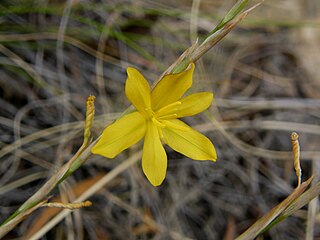
Dietes is a genus of six rhizomatous plant species of the iris family Iridaceae, first described collectively in 1866. Common names for the different species include wood iris, fortnight lily, African iris, Japanese iris and butterfly iris. Globally, these common names may differ from region to region, and may also apply to one or more species within Dietes.

Moraea, the Cape tulips, is a genus of plants in the family Iridaceae, first described as a genus in 1758. The group is widespread across Africa, the Mediterranean, and central and southwestern Asia. The genus name is a tribute to the English botanist Robert More.

Johannes Browallius, also called John Browall, was a Finnish and Swedish Lutheran theologian, physicist, botanist and at one time friend of Swedish taxonomist Carl Linnaeus.

Moraea aristata is a species of flowering plant in the family Iridaceae. It is referred to by the common names blue-eyed uintjie or Blouooguintjie in Afrikaans.It is endemic to the city of Cape Town and is considered to be critically endangered.

Swartland Shale Renosterveld is a critically endangered vegetation type of the Western Cape, South Africa.

Diplarrena moraea, commonly known as white iris, is a member of the iris family, Iridaceae. It occurs in Australian heathland and forest in New South Wales, Victoria and Tasmania.

Moraea gawleri is a species of plant in the family Iridaceae. The majority of its range lies around Western Cape province of South Africa, however it has also been recorded as far as Namaqualand to Humansdorp in the surrounding provinces.

Moraea macronyx is a species of plant in the family Iridaceae. It is found in Western Cape, South Africa.

Moraea tricolor is a species of plant in the family Iridaceae. It is found in Western Cape, South Africa.

Moraea fugacissima is a plant species in the family Iridaceae.

Moraea lewisiae is a species of flowering plant in the family Iridaceae.

Moraea miniata is a plant species in the family Iridaceae.

Moraea ochroleuca is a plant species in the family Iridaceae.

Moraea setifolia is a plant species in the family Iridaceae.

Moraea spathulata is a plant species in the family Iridaceae.

Moraea virgata is a plant species in the family Iridaceae.

Moraea sisyrinchium, the Barbary nut, is a species of flowering plant, a dwarf iris, in the genus Moraea, native to southern Europe and the Mediterranean region.

The von Linné family and Linnaeus family was the family of the renowned botanist, zoologist, taxonomist, physician and formalizer of the binomial nomenclature, Carl Linnaeus, and a Swedish noble family, ennobled on 20 April 1757 by the Swedish King Adolf Frederick, introduced at the House of Nobility in 1776. The von Linné family is predominantly famous for its contributions in the fields of science. The von Linné family descends from generations of priests and peasants in the historical province of Småland. The noble family's coat of arms prominently features a twinflower, one of Linnaeus's favourite plants.

Moraea serpentina is a flowering plant species in the genus Moraea. It is endemic to the Northern Cape and Western Cape of South Africa.



















